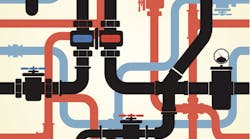Latest from Management
Sponsored
In last month’s article, we looked deep into the pipes of an old two-pipe gravity circulation system. We will now continue looking at the history and advances of these wonderful mechanical systems.
In this very same neighborhood near Capitol Hill, I came across a single-pipe gravity system that had its piping pitched upward from the gravity heat source, just like the two-pipe system. However, this system utilized a special fitting called a Eureka fitting. The Eureka tee was constructed such that it had two branch openings coming off of the top of the fitting, and a special baffle that was incorporated into the body of the tee. Hotter, less dense water would rise up out of the boiler’s sections and rise along the top half of the pipe, rising with the pipe headed for the radiators. As the hot water came to the Eureka tee, the hottest water was taken off the top of the pipe, and sent upward from the supply branch.
From this point on going upward to the risers, the piping system changed to a two-pipe system, with a supply and a return riser to flow through the cast-iron upright radiators, giving up the heat to the radiators, and then cooler water flowing back down the return pipe to the Eureka fitting. Within the Eureka fitting, there is an arrangement that brings the cooler return water back and introduces it to the lower half of the horizontal pipe, so essentially what you ended up with is hotter, less dense water flowing upward along the top of the pipe, and cooler, denser water flowing along the bottom of the mains, in a counter flow configuration. That’s right; water flowing in two different directions in the same pipe. This is a tough concept to visualize in one’s brain, and unless you happen to be so lucky as to have a thermal infrared imager on hand, you’d never think it was possible.
These systems do not like the application of a circulator. In fact, if you do apply a circulator to these systems in an effort to speed up the heating process, you will be disappointed at the performance of the system. The forced circulation will break up the stratification that is so critical to the operation of the system to the point where you have no differential in fluid temperature between the supply and return lines, and consequently very little or minimal output capacity of the heat emitters. The smallest flow, lowest head circulator you can find will probably be more pump than is necessary. Installer beware.
While we are on the subject of these grand old cast-iron and steel beauties, we should talk about radiator tapings and some of the fittings that were incorporated into that portion of the system. Many of the older systems had a throttling valve on them that is best described as a can with a half can inside of it that was cut in an elliptical shape. These were similar to a ball valve of today, and only required a quarter turn to go from the fully open position to closed. These are not a full shutoff type of valve, and in fact many of them had a quarter-inch hole drilled in them, so that it was impossible to close them off 100 percent and avoid the possibilities of a freeze break occurring in a room where the resident might have closed them completely off.
The clearance tolerances between these two cans were such that unless exercised on a regular basis, they would seize up in whatever position they happened to be in due to heavy oxides in the system water. In some cases, with a lot of WD-40 and tender loving care, this valve can be nursed back to life; but if that fails, I’d recommend replacing it with a non-electric thermostatic radiator control valve.
There was also a radiator valve that was invented by a man whose name should be familiar to you — Mark Honeywell. Mark invented what is known as a “unique radiator valve.” This valve allowed the installers to make supply and return connections to a radiator from one end, as opposed to having the supply enter one side and the return exit the other side of the radiator. It had a dip tube that was inserted into the radiators that was typically connected to the system supply. This introduced hot water to the bottom far side of the radiator where the water could rise up by gravity, giving up its heat and cooling the water down.
Even though many of these systems are still functional in delivering excellent comfort to the end users, their overall efficiencies are much less than today’s standards.
The cooler, denser water would settle into the lower sections of the radiator and exit through an annulus between the outer portion of the unique valve and the supply dip tube. The valve had a control handle on it, and when turned to the off position, still allowed gravity circulation between the supply and return tapings outside of the radiator.
Before we leave this world of antiquity, we should also discuss radiator tapings. Many of the older cast-iron, upright radiators had their supply and returns connected to the bottoms of the radiators. This methodology doesn’t make sense to our mind’s eye on first glance. It would make more sense in a gravity flow situation to have the hotter water enter through an upper tapping, and the cooler water return through a lower tapping. This is a method that was used, but not until the introduction of forced flow circulators around the 1920s, and even then, the hottest water entered the bottom tapping and the cooler water returned from the upper tapping.
This was more of an air control/ air elimination issue, but an important detail just the same. If you look closely at the bottom tapped radiators, you will see that the hottest water is allowed to rise through the interior sections of the casting, giving up its heat, and causing the cooler, denser water to flow downward in the exterior of the radiator, then out of the outlet tapping. If you place a level on the long axis of the radiator, you should be able to see the slightest pitch downward toward the radiator outlet. In many cases, this critical pitch was lost due to changes in floor coverings and/or the home settling, thereby causing a loss of pitch. In many situations, the radiator will still put out heat, just not as much as possible under ideal conditions.
Even though many of these systems are still functional in delivering excellent comfort to the end users, their overall efficiencies are much less than today’s standards. Retrofitting new heat sources and distribution piping systems can increase comfort and decrease energy consumption by as much as 50 percent.
In the next series of articles, we will look at all of the new manners and methods of system distribution piping, so that you will have the ability to make sound mechanical and financial decisions about how your next job will look and work. Sometimes, we get so used to dealing with a given methodology that we forget to look around and see what all of our options are, and how they affect the installed cost and operation of these wonderful comfort systems. Just because that’s the way you were taught and have always done it doesn’t necessarily mean it’s the only or best way of doing business. We hope to broaden your knowledge base, increase field labor efficiency, and minimize piping waste.
Tune in next month as we continue to disclose the many manners and methods of piping distribution and their application to your project.
If you’ve not yet joined the Radiant Professionals Alliance, please check us out at www.radiantprofessionalsalliance.org. We are here to help you become a true expert in the efficient delivery of comfort. Join today.
Mark Eatherton material on this website is protected by Copyright 2015. Any reuse of this material (print or electronic) must first have the expressed written permission of Mark Eatherton and CONTRACTOR Magazine. Please contact via email at: [email protected].
Mark Eatherton
Mark Eatherton material on this website is protected by Copyright 2017. Any reuse of this material (print or electronic) must first have the expressed written permission of Mark Eatherton and CONTRACTOR Magazine.


